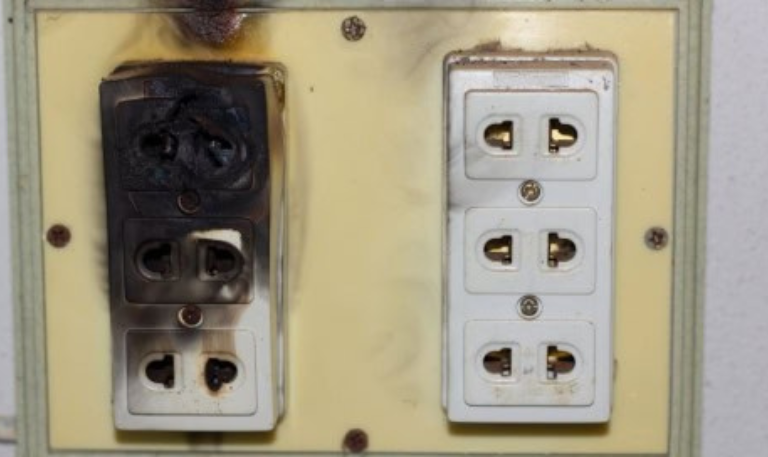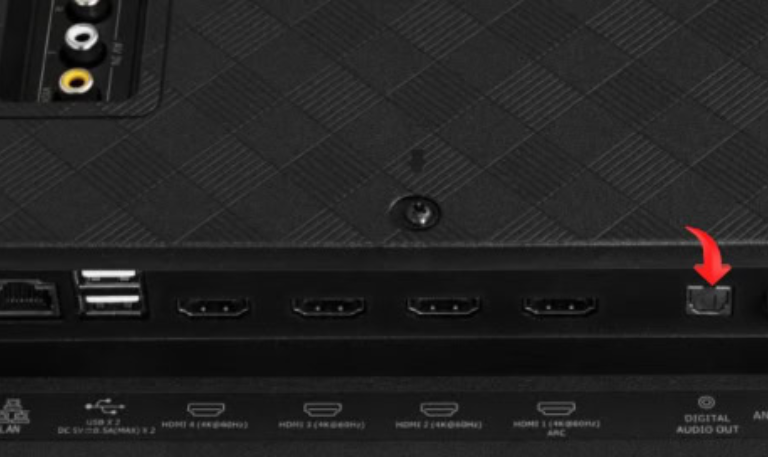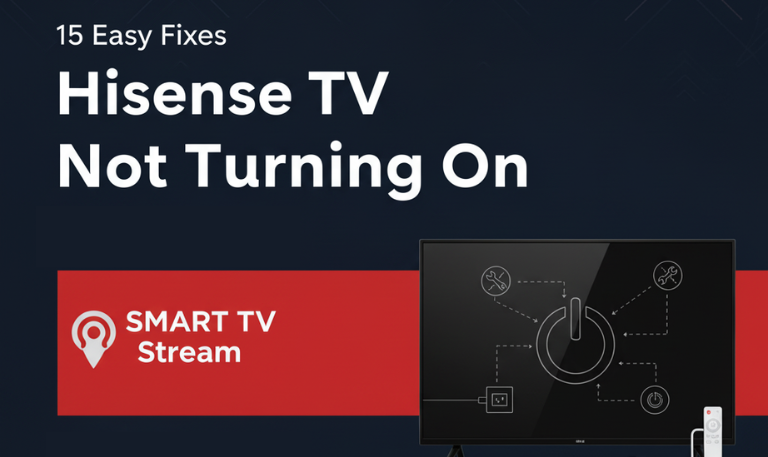It’s a frustrating feeling you grab the remote, press the power button, and… nothing happens. The screen stays black, no logo, no light, no sound. If your Hisense TV won’t turn on, you’re not alone. This issue is surprisingly common and can stem from several causes from simple remote control problems to deeper hardware faults like a damaged power board. The good news? Most of these issues can be fixed at home without calling a technician.
In this comprehensive guide, we’ll walk you through all the reasons why your Hisense TV isn’t turning on, how to fix it step by step, and what to do if none of the fixes work.
Common Reasons Why Your Hisense TV Won’t Turn On
Before jumping into the fixes, it helps to know the most likely causes. A Hisense TV not turning on usually points to one of the following issues:
Power supply or wall socket problems
Loose or faulty cables
Remote control malfunction or low batteries
Internal power board failure
Firmware bugs or system freeze
Faulty LED backlight
Mainboard malfunction
Surge or electrical spike damage
Understanding the cause helps you choose the right fix without wasting time or effort.
Read More: ESPN on Roku
Step-by-Step Fixes for Hisense TV Not Turning On
Let’s go through the most effective solutions, starting with the easiest.
1. Check Power Supply and Connections

Start with the basics. Make sure your TV is actually getting power.
What to do:
Unplug the power cord from the TV and the wall outlet.
Wait 30 seconds and plug it back in firmly.
Try a different wall socket or connect another device (like a lamp) to check if the outlet works.
If using a surge protector, remove it temporarily these sometimes fail and block power.
If the power LED still doesn’t light up, continue to the next step.
2. Inspect the Power Cable
A loose or damaged cable is one of the most common culprits.
What to check:
Look for visible cuts, frays, or bends in the cable.
Ensure the cord is tightly connected to the TV’s power port.
Try another compatible power cable (if available).
A faulty cable can interrupt the current and make your TV appear dead.
3. Perform a Soft Power Reset
Sometimes, a simple power reset is enough to revive your Hisense TV.
Steps:
Unplug the TV from power.
Press and hold the Power button on the TV (not the remote) for 30 seconds.
Release the button and wait 60 seconds.
Plug the TV back in and press the Power button again.
This drains residual electricity and resets the internal power circuits. In most cases, this alone fixes the “no power” issue.
4. Try the TV’s Power Button (Not the Remote)
Sometimes the issue isn’t with the TV, but the remote control.
Find the power button on the bottom or back of your Hisense TV.
Press and hold it for 5–10 seconds to turn the TV on.
If the TV powers up, your remote might be the problem.
We’ll troubleshoot the remote next.
5. Check the Remote Control

A dead or unresponsive remote is often mistaken for a TV power issue.
Here’s what to do:
Replace the remote’s batteries with fresh ones.
Point it directly at the TV sensor and press Power.
Use your phone’s camera to check if the remote’s IR light flashes when you press buttons (you’ll see a small light in your phone camera if it’s working).
If the remote isn’t working, try using the Hisense RemoteNOW App on your smartphone (available for Android and iOS). It connects via Wi-Fi and can power on the TV if the mainboard is responsive.
6. Look for a Standby Light
Your Hisense TV usually has a small red or white LED near the power button. This light gives you clues:
Light On: TV is in standby mode. Try turning it on with the remote or power button.
Light Off: No power is reaching the TV or the LED itself has failed.
Light Blinking: Indicates the TV is trying to boot or has detected an internal fault.
Use this indicator to narrow down the problem source.
7. Disconnect External Devices

Sometimes, HDMI devices like gaming consoles, streaming sticks, or Blu-ray players can cause power conflicts.
Try this:
Unplug all HDMI and USB devices.
Wait for a minute.
Try turning the TV on again.
If it turns on now, reconnect devices one by one to identify which one caused the problem.
8. Power Cycle All Connected Devices
If your TV is connected to a set-top box, soundbar, or receiver, those might be causing startup conflicts.
Fix:
Turn off and unplug all devices (TV, soundbar, console, etc.).
Wait 2–3 minutes.
Plug the TV back in first and power it on.
Then reconnect each device one at a time.
9. Try a Different Power Outlet or Room
There’s a chance your home circuit or wall socket is faulty. Move the TV to a different room or plug it into another outlet to test.
If it works there, the issue is with your outlet, not the TV.
10. Check for Power Surge or Burn Smell
If your Hisense TV stopped working after a storm or power surge, it might have damaged internal components.
Check for:
Burnt smell near the back panel
Flickering standby light before dying
TV not responding at all even after resets
In such cases, internal power board replacement may be needed.
11. Reset Using the Button Combination (For Smart TVs)
Some Hisense smart TVs allow manual reset via buttons.
Try this:
Unplug the TV.
Press and hold the Volume Down and Input buttons on the TV panel.
Keep holding and plug the TV back in.
Continue holding for 15 seconds, then release.
This can trigger a forced restart and clear firmware issues.
12. Inspect the Backlight (for Black Screen Issue)
If you hear sound but see no picture, your TV backlight might be dead.
Test method:
Turn on the TV and shine a flashlight at the screen at a close angle.
If you can see faint images or menus, the backlight is faulty.
Replacing the LED backlight requires opening the panel, which is best done by a technician.
13. Factory Reset via Side Buttons (if accessible)
If the TV turns on but won’t display properly or seems stuck on the logo, you can try a factory reset.
Steps:
Press and hold the Reset button (usually a small pinhole) on the back or bottom of the TV.
Hold it for 15–30 seconds until the Hisense logo appears.
The TV will reboot and restore factory settings.
14. Update or Reinstall Firmware
Corrupted firmware can cause the TV to fail during startup.
If your TV occasionally turns on but freezes or goes black, update its software.
How to update:
Go to Settings → Support → System Update.
Choose “Check for Updates.”
Let the update install fully before restarting.
If the TV won’t turn on at all, you can download firmware from the Hisense website on a USB drive and perform a USB firmware recovery (instructions are model-specific).
15. Contact Hisense Support or a Technician
If none of these steps work, your TV likely has a hardware fault such as:
Blown capacitors on the power board
Shorted mainboard
Damaged inverter or T-Con board
You can contact Hisense customer service at their official website or warranty support line.
Have your model number, serial number, and purchase receipt ready.
If your warranty has expired, a local repair shop can usually replace the power board for $80–$150, depending on the model.
Preventing the Issue in the Future
Once you’ve fixed your Hisense TV, take a few preventive steps to avoid facing the same issue again.
Use a high-quality surge protector. Prevents power spikes during storms.
Turn off your TV properly. Avoid unplugging while it’s on.
Keep vents dust-free. Overheating can damage internal boards.
Update software regularly. Bug fixes prevent firmware crashes.
Avoid overloading HDMI ports. Disconnect unused devices.
A little care goes a long way in extending your TV’s life.
When to Replace Instead of Repair
If your Hisense TV is older than 5–7 years, and the repair cost exceeds 40% of the TV’s value, it’s often smarter to replace it. Modern Hisense models offer better energy efficiency, 4K or 8K displays, and advanced smart features often at lower prices than a major board replacement.
Read More: Netflix Keeps Crashing on Roku
Troubleshooting Summary
| Problem | Possible Cause | Fix |
|---|---|---|
| No power light | Power cable or board issue | Check outlet, replace cable |
| Power light on, no display | Backlight failure | Test with flashlight |
| Remote not working | Dead batteries or blocked sensor | Replace batteries, clean sensor |
| Turns off immediately | Faulty mainboard | Reset or service |
| Logo stuck | Corrupted firmware | Factory reset or firmware update |
| Blinking red light | Internal error | Contact support |
| Sound but no image | Backlight issue | Replace LED backlight |
| Works then shuts off | Overheating or short circuit | Ensure ventilation |
Hisense TV Not Turning On FAQs
Q: Why is my Hisense TV not turning on but the red light is on?
If the red standby light is on but your TV won’t power up, it usually means the power board is receiving current but the mainboard isn’t responding. Try a power reset (unplug and hold the power button for 30 seconds). If it still doesn’t turn on, your TV might have a faulty mainboard or firmware issue.
Q: My Hisense TV won’t turn on and there’s no light at all what does it mean?
This typically indicates that no power is reaching the TV. Check your outlet, try another cord, and test the outlet with another device. If there’s still no light, the internal power board or fuse may be blown.
Q: What should I do if my Hisense TV clicks but doesn’t turn on?
That clicking sound often means the power board is trying to start but can’t sustain the power cycle. Perform a soft reset and unplug the TV for several minutes. If it keeps clicking, it may require board replacement.
Q: Can a faulty HDMI device stop my Hisense TV from turning on?
Yes. In some cases, a malfunctioning HDMI device or cable can cause voltage feedback that prevents the TV from booting. Disconnect all HDMI and USB devices, then try turning the TV on again.
Q: Why does my Hisense TV turn off right after turning on?
If your TV powers up and shuts off quickly, it could be due to overheating, a shorted capacitor, or corrupted software. Clean the vents, allow it to cool, and perform a factory reset.
Q: How do I reset my Hisense TV if it won’t turn on?
Unplug the TV, press and hold the power button for 30 seconds, then plug it back in. Alternatively, press and hold the reset button on the back (if available) for 20 seconds while plugging it in.
Q: How can I tell if the backlight is the problem?
Turn on the TV and shine a flashlight at the screen. If you can faintly see the image, your backlight is defective and needs replacement.
Q: How long does a Hisense TV usually last?
Hisense TVs typically last 5–8 years with regular use, depending on model and environment. Regular cleaning and proper ventilation help extend lifespan.
Q: Is it worth repairing a Hisense TV that won’t turn on?
If your TV is under warranty, absolutely. If not, and the repair costs exceed 40–50% of the price of a new model, replacing it might be more practical.
Q: Can power surges permanently damage a Hisense TV?
Yes. A strong surge can fry the internal fuse or power board instantly. Always use a quality surge protector, especially if you live in an area prone to electrical fluctuations.
Conclusion

A Hisense TV not turning on can be worrying, but in most cases, it’s not a death sentence for your TV. Simple fixes like checking the power cable, resetting the TV, or replacing remote batteries often bring it back to life. If your TV remains unresponsive after trying all the steps, the issue likely lies in the power board or mainboard, which may require professional repair. Remember regular maintenance, using surge protectors, and keeping your software updated can help prevent this issue in the future.
Pillar Post:

![Roku Developer Mode Explained [2025 Guide] | How to Enable 15 Roku Developer Mode Explained [2025 Guide] How to Enable](https://smarttvstream.com/wp-content/uploads/2025/11/Roku-Developer-Mode-Explained-2025-Guide-How-to-Enable.png)
![How to Turn Up Volume on Roku TV & Remote [2025 Guide] 16 How to Turn Up Volume on Roku TV & Remote [2025 Guide]](https://smarttvstream.com/wp-content/uploads/2025/10/How-to-Turn-Up-Volume-on-Roku-TV-Remote-2025-Guide.png)
